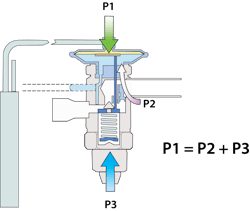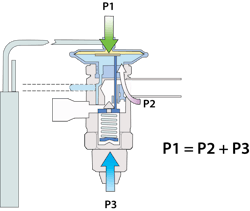Five Ways to Prevent Thermostatic Expansion Valve Misdiagnosis from Low Airflow
This time of year, a common misdiagnosis is replacing a perfectly good thermostatic expansion valve (TEV). If refrigerant pressures are off, it must be the valve, right? Instead of diagnosing the real problem, it becomes the refrigeration version of "Pin the Tail on the Donkey."
It's easy to miss how low airflow affects the operation of a valve if you're unsure of the symptoms. Let's look at five ways to help prevent TEV misdiagnosis and discover actual issues affecting a system.
Know How a TEV Operates
The primary purpose of a TEV in cooling operation is to control the flow of liquid refrigerant into the indoor coil of an HVAC system. So, the TEV should meter refrigerant into the indoor coil at the same rate it boils off. Remember this vital fact when considering the impact of low airflow.
The TEV meters refrigerant by maintaining a certain amount of superheat as the refrigerant flows back to the compressor. Superheat is typically in the 8-to-12-degree range for most residential applications, though this value can vary by equipment manufacturer.
The valve senses three pressures to maintain superheat. They are:
- Pressure is exerted by the refrigerant charge in a remote-sensing bulb on the diaphragm mounted on top of the valve body.
- Pressure exerted from the refrigerant pressure in the indoor coil.
- Pressure from the TEV spring.
The bottom of the diaphragm senses indoor coil refrigerant pressure. As refrigerant pressure in the indoor coil increases, the diaphragm moves up. The valve then closes and allows less refrigerant to flow through the coil. Besides indoor coil pressure, spring pressure also acts on the bottom of the diaphragm.
As these three pressures fluctuate, the valve adjusts to maintain superheat from the indoor coil. Once fan airflow is correct, this is easy for the valve to achieve. But when fan airflow is low, valve operation becomes erratic because refrigerant in the indoor coil boils off too slowly.
Understand How Low Airflow Effects Indoor Coil Heat Load
When airflow across the indoor coil drops below an acceptable range, the heat load on the coil decreases because of lower heat transfer. The refrigerant boils off at a much slower rate than called for by the system design.
While this happens, indoor coil outlet temperature drops rapidly. This rapid temperature drop causes the valve to close because of overfeeding. As a result, refrigerant flow through the coil drops. This is called valve underfeeding.
Valve underfeeding now starves the coil for refrigerant and causes a rise in coil outlet temperature. The valve responds to the increase in temperature and opens back up, causing more refrigerant to feed into the coil. As a result, the valve continuously searches for a stable point.
The refrigerant still cannot boil off fast enough with low airflow, and refrigerant overfeeding repeats. The valve overfeeding and underfeeding cycle continues until the thermostat is satisfied or airflow improves.
Unfortunately, every time the valve overfeeds, there is a potential for floodback at the compressor as the valve searches for stability. When the valve underfeeds, it denies the compressor the proper cooling necessary to prevent overheating. The compressor eventually gives out and fails because of repeated long-term abuse.
Identify Thermostatic Expansion Valve Hunting
When TEV operation becomes unstable, it's referred to as hunting. Hunting occurs when the valve is trying to find a balance point. However, it cannot because of low fan airflow not removing heat from the refrigerant as quickly as the system needs.
Hunting shows up as fluctuations in refrigerant pressure and refrigerant line temperatures.
Hunting shows up as fluctuations in refrigerant pressure and refrigerant line temperatures. Superheat decreases and increases as the valve searches for a stabilization point. So, you need to measure refrigerant pressures and temperatures to uncover this defect in operation.
Perform a Visual Inspection
If you encounter TEV hunting, the first step is a thorough visual inspection of the system. Next, look for noticeable defects in the condition of system components, such as the blower wheel, indoor coil, air filter, cabinet insulation, and duct system. Your problem might be as simple as a dirty air filter or blower wheel.
If the system components are clean and in good shape, look closer at the equipment model numbers and fan speed settings. Look for anything that could be a clue for improper equipment setup or installation affecting fan airflow.
Check Fan Airflow
If your visual inspection checks out, check fan airflow. Don't replace the valve yet. The simplest method for a technician to estimate fan airflow is to measure total external static pressure (TESP) and fan speed, then plot fan airflow using the manufacturer's fan tables.
MeasureQuick software can reveal low airflow using temperature and refrigerant-side diagnostics if you have the right test instruments.
MeasureQuick software can reveal low airflow using temperature and refrigerant-side diagnostics if you have the right test instruments. These invaluable tests help you determine whether the indoor coil's lack of airflow hinders the valve's operation. They also help you diagnose the true cause of erratic TEV operation.
Stop Pinning Blame
Don't replace a perfectly good TEV because you overlooked airflow issues. Operating conditions often cause TEV "misbehavior." So, before you condemn your next TEV, make sure you've considered the five points above.
Unless you understand how a TEV works, how low airflow affects them, and have performed both a visual inspection and checked airflow, TEV replacement is an initial knee-jerk reaction. It's a rough day when you discover the new TEV has the same problem as the one you replaced. Playing refrigeration pin the tail on the donkey usually leaves you looking like the game's target.
David Richardson serves the HVAC industry as Director of Training for the National Comfort Institute, Inc. (NCI). NCI specializes in training focusing on improving, measuring, and verifying HVAC and Building Performance.
If you're an HVAC contractor or technician interested in learning about how to diagnose airflow problems, contact David at ncilink.com/ContactMe. NCI's website, www.nationalcomfortinstitute.com, is full of free information to help you improve your professionalism and strengthen your company.
About the Author
David Richardson
Director, technical curriculum
David Richardson serves the HVAC industry as director of technical curriculum at National Comfort Institute, Inc. (NCI), Avon, Ohio. NCI specializes in training that focuses on improving, measuring, and verifying HVAC and Building Performance.

